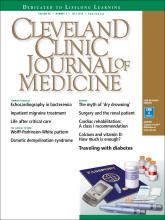Article Figures & Data
Tables
Markers of kidney damage
(≥ 1 present for > 3 months)Albuminuria
(albumin excretion rate ≥ 30 mg/day; albumin-creatinine ratio ≥ 30 mg/g)Urinary sediment abnormalities Electrolyte and other abnormalities due to tubular disorders Abnormalities detected by histology Structural abnormalities detected by imaging History of kidney transplant Decreased glomerular filtration rate (GFR)
(present for > 3 months)GFR < 60 mL/min/1.73 m2 (GFR categories G3a to G5) Reprinted from Kidney International Supplements, 3:19–62, KDIGO. Chapter 1: definition and classification of CKD, copyright 2013, doi:10.1038/kisup.2012.64, with permission from Elsevier.
Stage GFR, mL/min/1.73 m2 Descriptor G1 ≥ 90 Normal or high G2 60–89 Mildly decreaseda G3a 45–59 Mildly to moderately decreased G3b 30–44 Moderately to severely decreased G4 15–29 Severely decreased G5 < 15 Kidney failure Albuminuria AER, mg/day ACR, mg/g Descriptor A1 < 30 < 30 Normal to mildly increased A2 30–300 30–300 Moderately increasedb A3 > 300 > 300 Severely increased ↵a In the absence of evidence of kidney damage, neither GFR category G1 nor G2 meets the criteria for chronic kidney disease.
↵b Includes the nephrotic syndrome (AER usually > 2,200 mg/day).
ACR = albumin-creatinine ratio equivalent; AER = albumin excretion rate; GFR = glomerular filtration rate
Reprinted from Kidney International Supplements, 3:19–62, KDIGO. Chapter 1: definition and classification of CKD, copyright 2013, doi:10.1038/kisup.2012.64, with permission from Elsevier.
Cardiac surgery Noncardiac surgery Patient factors Age > 75 Age ≥ 59 Chronic kidney disease Body mass index ≥ 32 kg/m2 Diabetes mellitus (type 1 > type 2) Peripheral vascular occlusive disease Anemia Hepatic disease, especially chronic kidney disease Congestive heart failure Chronic obstructive pulmonary disease Left ventricular dysfunction African American race Pulse pressure > 40 mm Hg Hypertension Prior myocardial infarction Diabetes Angiotensin-converting enzyme inhibitors (but evidence conflicting) Surgical factors Urgent surgery Emergency surgery Duration of procedure High-risk surgery (intrathoracic, intraperitoneal, suprainguinal vascular, with potential for large blood loss or large fluid shifts) Cardiopulmonary bypass > 2 hours Intra-aortic balloon pump use Total vasopressor dose Multiple inotrope usec Vasopressor infusion Off-pump coronary artery bypass grafting (vs on-pump) Diuretic administration Adapted from information in references 7, 15, 17, 23–27, 30–32, 34.
- TABLE 4
Recommendations for perioperative prevention and management of acute kidney injury
Use isotonic crystalloids rather than colloids for volume expansion in the absence of hemorrhagic shock Use vasopressors in conjunction with fluids to manage vasomotor shock in patients at risk of acute kidney injury Use protocol-based management of hemodynamics and oxygenation parameters in high-risk patients in perioperative setting or patients in septic shock Target a total energy intake of 20 to 30 kcal/kg/day in patients with acute kidney injury Avoid nephrotoxic medications such as aminoglycosides Use renal dosing for medications Adapted from information in reference 15.






